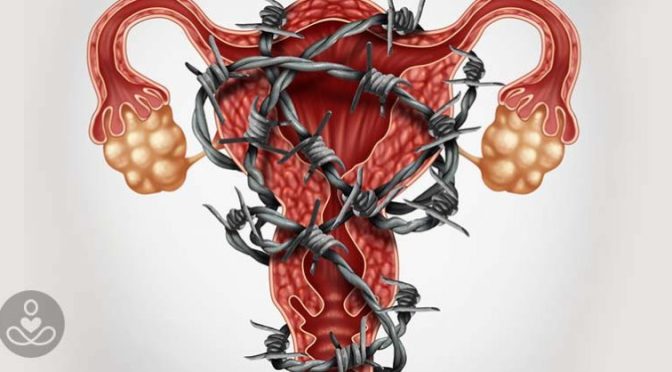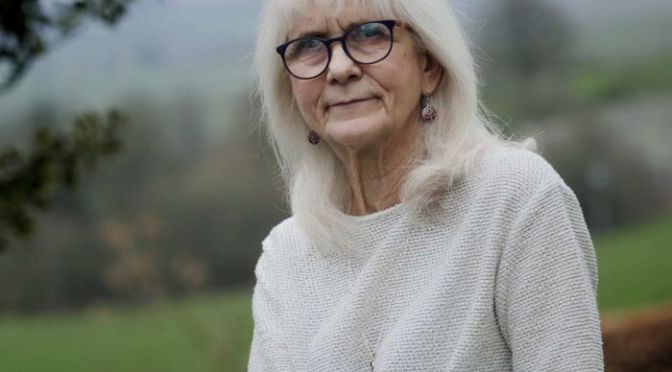Feature Image of artistic depiction of female pelvic area in pain due to endometriosis sourced from:
https://theheartysoul.com/endometriosis-heart-disease-risk/
Dear Pain Matters readers,
JESSICA HIRST, ENDOMETRIOSIS SUFFERER FOR 17 YEARS, WIFE AND MOTHER
Hearing about women like Jessica Hirst inspired me to write this blog post today:
Jessica Hirst (28), a mother of a baby boy, has endured severe pelvic pain due to aggressive endometriosis since she was 11 when her periods started.

Jessica and her family
Source: https://www.mamamia.com.au/endometriosis-stories/
Quoting Jessica:
‘It feels like someone is stabbing me repeatedly in the abdomen. I get a constant burning pain. There’s an aching that starts in my lower back and comes right down through my legs … it feels like there’s a bowling ball in my uterus.’
Unable to work due to pain, Jessica relies on her husband as her full-time carer. Despite her excruciating pelvic pain, Jessica finds joy and happiness in their 18-month old baby boy. Jess is urgently in need of treatment.
Source: ‘It’s like someone’s stabbing me in the abdomen.’ – Jessica has been in pain since she was 11 (by Gemma Bath, 18 April 2019).
https://www.mamamia.com.au/endometriosis-stories/
OVERVIEW
Endometriosis is a painful disorder that affects up to 10% of all women of child-bearing age. This includes approximately 1.5 million women in the UK and 176 million women worldwide.
Furthermore, 71% to 87% of all women with chronic pelvic pain plus 38% of all infertile women have endometriosis.
Endometriosis occurs when the tissue similar to the lining inside the uterus (i.e. endometrium) grows outside of the uterus. This tissue may be found on the ovaries, fallopian tubes, tissue lining the pelvis (i.e. pelvic peritoneum), ureter, bladder, bowel and recto-vaginal septum. It has even been found in the lungs and diaphragm in rare instances.
Endometriosis can cause severe pelvic pain during periods, ovulation and/or sex. Heavy and/or irregular menstrual cycles, infertility, low energy levels, poor sleep and fatigue result. Symptoms vary depending on where the rogue endometrium grows. This can affect the women’s overall health and well-being (Amsterdam et al, 2005).
DIAGNOSIS AND TREATMENT OPTIONS
Diagnosis
Women often suffer years of pain before they are finally diagnosed with endometriosis. It takes 7.5 years on average before endometriosis is diagnosed. This is because the pain and other symptoms are all-too-often dismissed as ‘normal’ and ‘not serious’.
Endometriosis is diagnosed via biopsy obtained during diagnostic laparoscopy. This involves keyhole surgery under general anaesthetic.
Treatment Options
Endometriosis is said to be incurable (Howarth, 2019) …
… but is this always true?? Read on…
Several treatments exist that may offer relief from pelvic pain due to endometriosis:
- Oral contraceptives;*
- Aromatase inhibitors (e.g. letrozole, anastrazole); and
- Surgery (excision) to remove endometrial tissue that grows outside of the uterus.
Whilst excision of endometriosis may offer pain relief in some women, multiple surgeries may be required. Furthermore, there is a risk of recurrence. Finally, surgery is more invasive than treatment involving aromatase inhibitors.
Studies suggest that aromatase inhibitors (e.g. letrozole; anastrazole) may reduce masses hence leading to relief from pelvic pain due to endometriosis.
Aromatase inhibitors have been used to treat postmenopausal breast cancer patients for over 10 years.
SUCCESSFUL STUDIES AND CASES INVOLVING AROMATASE INHIBITORS FOR PELVIC PAIN AND ENDOMETRIOSIS
(1) An American Study (N=10) Involving Aromatase Inhibitors (Letrozole)
An American study found that aromatase inhibitors (letrozole) significantly reduced pelvic pain due to endometriosis in 9 of 10 patients.
Ten (10) premenopausal patients with endometriosis who had undergone surgical and medical treatment were selected for this study.
Endometriosis was confirmed via biopsy obtained during diagnostic laparoscopy.
Oral treatment of letrozole, together with norethindrone acetate, calcium citrate (to minimize bone loss) and vitamin D (to strengthen bones), was offered daily for 6 months.
Second-look laparoscopy was done following letrozole treatment for 6 months.
The good news:
This 2nd biopsy showed nil endometriosis in all 10 patients. Nada!
Furthermore, pelvic pain due to endometriosis was significantly reduced in 9 out of 10 patients following letrozole treatment for 6 months. Bone density appeared unaffected.
In conclusion, letrozole may offer effective treatment for endometriosis (Ailawadi et al, 2004).
(2) A 2nd American Study (N=15) Involving Aromatase Inhibitors (Anastrazole)
A 2nd American study led by the same doctor revealed that another aromatase inhibitor called anastrazole also decreased pelvic pain due to endometriosis.
Fifteen (15) premenopausal patients with endometriosis and pelvic pain were selected for this study.
Oral treatment of anastrazole and oral contraceptive was offered daily for 6 months. Anastrazole treatment led to suppression of estradiol levels.
The good news:
Fourteen of 15 endometriosis patients obtained significant pain relief following 6 months of anastrazole treatment. Specifically, median pain levels were reduced by 55% while mean pain scores were decreased by 40%.
In conclusion, anastrazole may offer effective treatment for endometriosis (Amsterdam et al, 2005).
(3) A Young Italian Woman with Endometriosis Finally Found Relief from Severe Pelvic Pain Thanks to Letrozole (After Ovariectomy Failed to Offer Pain Relief)
A young Italian woman named ‘Maria’ (not her real name) with aggressive endometriosis finally found relief from severe pelvic pain thanks to daily oral aromatase inhibitor (letrozole) treatment for 9 months.
Maria had initially undergone a subtotal hysterectomy as well as removal of both ovaries in an unsuccessful bid to reduce pelvic pain.
Following 3 months of daily oral letrozole treatment, Maria’s pelvic pain including pain during sex was significantly reduced. Her pelvic ultrasound showed nil endometrial tissue in the pelvis. Maria’s bone density remained unchanged thanks to daily calcium and Vitamin D supplements.
Given these encouraging results, treatment was continued for another 6 months.
In summary, daily oral aromatase inhibitor (letrozole) treatment may relieve severe pain in young women with endometriosis (Razzi et al, 2004).
(4) The First Woman to be Successfully Treated for Endometriosis via an Aromatase Inhibitor (Anastrozole)
An American woman (57) named ‘Jane’ (not her real name) with aggressive postmenopausal endometriosis finally found relief from severe pelvic pain thanks to daily oral aromatase inhibitor (anastrozole) treatment for 9 months.
Jane had previously undergone a hysterectomy as well as removal of her ovaries and fallopian tubes.
Guess what happened next?
Jane’s pelvic pain completely vanished after 2 months of daily oral anastrozole treatment!
Furthermore, a large 30mm X 30mm X 20mm bright red vaginal lesion had reduced to a mere 3mm gray tissue after 9-month anastrozole treatment.
Bone density was however decreased by 6.2% following 9 months of aromatase inhibitor treatment.
Aromatase inhibitors may offer benefits including pain relief and substantial eradication of endometrial tissue (
(5) Two Sisters Successfully Treated for Severe Endometriosis via an Aromatase Inhibitor (Anastrozole)
Two sisters, aged 24 and 26, had undergone several minimally invasive surgeries (i.e. laparoscopies) that, unfortunately, failed to alleviate severe pelvic pain due to aggressive endometriosis.
Both women received oral aromatase inhibitors (anastrozole), oral contraceptives (for birth control), calcitriol (to minimise bone loss) and rofecoxib (for pain control) on a daily basis for 21 days followed by 7 days off (i.e. a cycle). Six cycles were offered over 6 months.
Within only 3 months, pelvic pain and other symptoms of endometriosis were eliminated in both sisters. These positive effects lasted over a year, post-treatment.
There was nil evidence of endometriosis disease in one of the 2 sisters, as confirmed via laparoscopy done 15 months after treatment.
Bone densities remained normal in both sisters after treatment (Shippen & West, 2004).
(6) A Woman (55) Successfully Treated for Endometriosis via an Aromatase Inhibitor (Letrozole)
‘Joan’ (55) in Belgium (not her real name) underwent a total abdominal hysterectomy 10 years earlier.
Recently, Joan had right-sided sciatic pain that radiated down her right leg due to recurring endometriosis.
A pelvic ultrasound confirmed an endometrial mass that compressed against her lumbo-sacral plexus. This mass was 4cm X 8cm in size.
A daily oral aromatase inhibitor (letrozole) was offered to treat this large mass.
After 12 months of letrozole treatment, Joan no longer had sciatic pain. Following 18 months of treatment, Joan’s mass had shrunk to only 1cm in size.
Due to a successful outcome, oral letrozole was stopped after 21 months.
Recurring endometriosis may successfully be treated via an aromatase inhibitor (letrozole). This is a less invasive treatment option than surgery (Fatemi, 2005).
THE SCIENCE BEHIND ENDOMETRIOSIS AND AROMATASE INHIBITORS
An enzyme called aromatase is important in oestrogen production. This enzyme is absent in normal endometrium in the uterus.
However, this enzyme is aggressively produced in endometriosis, an oestrogen-dependent disease. Increased aromatase activity leads to high estradiol levels in endometriosis.
Being potent oestrogen blockers, aromatase inhibitors ‘starve’ endometrial tissue of oestrogen. This leads to shrinkage, and in some cases, complete elimination of endometriosis.
Thus, in the presence of aromatase inhibitors (that block oestrogen production), endometriosis may shrink, and even vanish altogether, during daily letrozole or anastrazole treatment for a certain period of time.
Aromatase inhibitors exert their anti-oestrogen effects on ovaries and on endometrial tissue growing outside of the uterus (Bulun et al, 2001; Ailawadi et al, 2004; Bulun et al, 2004; Amsterdam et al, 2005; Fatemi, 2005).
SUMMARY
In addition to oral contraceptives* and excision, aromatase inhibitors (e.g. letrozole, anastrazole) may offer effective treatment for endometriosis (Ailawadi et al, 2004; Amsterdam et al, 2005; Hofmann-Werther)
Isn’t this exciting?
If you know someone with endometriosis, please forward this blog post to her.
Wishing all pain patients inspiration, hope and empowerment,
Sabina Walker
PS From a patient’s perspective, Gabrielle Jackson’ book called Pain and Prejudice offers enormous insight into endometriosis (Jackson, 2019).
Sabina Walker, Masters Appl. Science (Neuroscience)
Blogger of Pain Matters (in WordPress)
painmatters.wordpress.com
and
Author of soon-to-be published book called Pain Matters
@SabinaWalker18
REFERENCES
MEDIA
(1) Howarth, Angus. Lack of cash hinders research into condition affecting 10% of women. The Scotsman (8 April 2019).
(2) Facts about endometriosis.
http://endometriosis.org/resources/articles/facts-about-endometriosis/
(3) Bulun, Serdar & Wood, Ros. Aromatase in endometriosis.
http://endometriosis.org/resources/articles/aromatase/
* (4) Endometriosis in adolescence. Women’s Health Queensland
https://womhealth.org.au/conditions-and-treatments/endometriosis-adolescence
(5) Hofmann-Werther, Amelie. Chronic pelvic pain and endometriosis. Middle East Medical.
https://www.middleeastmedicalportal.com/chronic-pelvic-pain-and-endometriosis/
BOOK
(1) Jackson, Gabrielle. Pain and Prejudice – A Call to Arms for Women and their Bodies. Allen & Unwin (2019).
ISBN 978 1 76052 909 3
PEER-REVIEWED PAPERS
(1a) Amsterdam et al. Anastrazole and oral contraceptives: a novel treatment for endometriosis. Fertility and Sterility (Aug 2005); 84(2), 300–304.
doi: https://doi.org/10.1016/j.fertnstert.2005.02.018
https://www.fertstert.org/article/S0015-0282(05)00859-9/fulltext
(1b) Ailawadi et al. Treatment of endometriosis and chronic pelvic pain with letrozole and norethindrone acetate: a pilot study. Fertility and Sterility (Feb 2004); 81(2): 290–296.
doi: https://doi.org/10.1016/j.fertnstert.2003.09.029
https://www.fertstert.org/article/S0015-0282(03)02874-7/fulltext
(1c) Bulun et al. Aromatase and endometriosis. Semin Reprod Med (Feb 2004); 22(1): 45-50.
https://www.ncbi.nlm.nih.gov/pubmed/15083380
(1d) . Treatment of severe postmenopausal endometriosis with an aromatase inhibitor. Fertil Steril (1998); 69: 709– 713.
https://www.ncbi.nlm.nih.gov/pubmed/9548162?dopt=Abstract
(1e) Bulun et al. Role of aromatase in endometrial disease. J Steroid Biochem Mol Biol (Dec 2001); 79(1-5): 19-25.
https://www.ncbi.nlm.nih.gov/pubmed/11850203
(2) Razzi et al. Treatment of severe recurrent endometriosis with an aromatase inhibitor in a young ovariectomised woman. BJOG (Feb 2004); 111(2): 182-184.
https://doi.org/10.1046/j.1471-0528.2003.00038.x
https://obgyn.onlinelibrary.wiley.com/doi/full/10.1046/j.1471-0528.2003.00038.x
(3) Shippen & West. Successful treatment of severe endometriosis in two premenopausal women with an aromatase inhibitor. Fertil Steril (May 2004); 81(5): 1395-8.
https://www.fertstert.org/article/S0015-0282(04)00147-5/fulltext
(4) Fatemi, Human Mousavi. Successful treatment of an aggressive recurrent post-menopausal endometriosis with an aromatase inhibitor. RBM Online (2005); 11(4): 455-457.
https://www.rbmojournal.com/article/S1472-6483(10)61140-6/pdf
SUPPORT GROUP FOR ENDOMETRIOSIS PATIENTS
There are many support groups including:
(1A) Endometriosis – Perth Sisterhood of Support.
https://www.endoperthsisters.com
Above support group is run by endometriosis sufferers, Joanne McCormick and Monique Alva (see below story).
(1B) Hedley, Kate. ‘The bad days are shocking’: Fresh hope for endometriosis sufferers. WA Today (15 Dec 2017).




